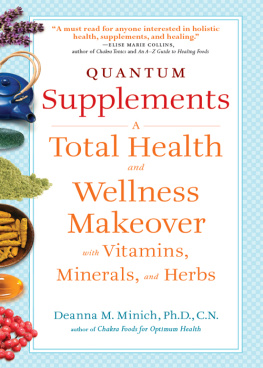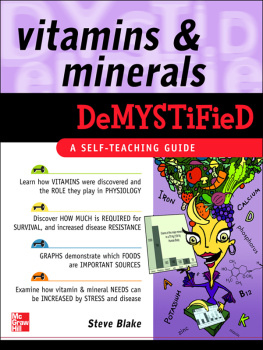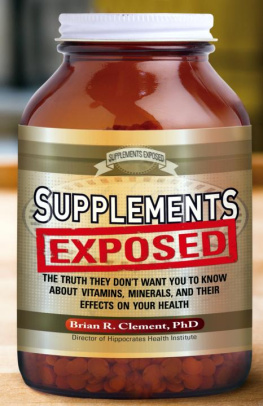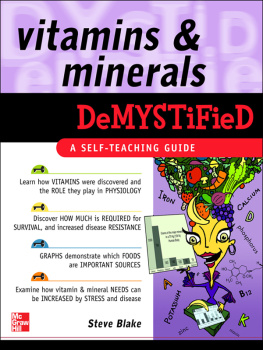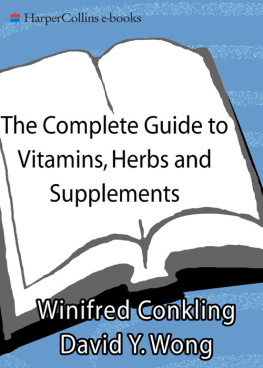INTRODUCTION
TAPPING INTO NATURES VITAL HEALING POWER
V itamins are not magic pills. But lets face it: Its really tempting to think of them that way. Anything that can help you live longer, look younger, enhance your immune system, fight illness, and boost your energy certainly sounds pretty miraculous or magical.
A few decades ago, when word started to spread about the healing potential of vitamins and minerals, the general public went wild for bottled nutrients. So did health writers and even some doctors. For a while, it was starting to sound like megadoses of vitamins could cure anything.
Well, that bubble burst soon enough. Of course, vitamins and minerals cant cure everything. But they can do a lot. Research breakthroughs over just the past few years are making interest in the topic heat up all over again. Some of the things that scientists have discovered about the healing power of these vital nutrients all but boggle the mind.
As more and more rigorous scientific studies accumulate showing spectacular health benefits from vitamins and minerals, were all back where we were a few decades ago: eager to take advantage of all of this healing potentialand thoroughly confused. While the reasons for taking vitamins and minerals are now based on solid science, shopping for nutrients is still nothing less than overwhelming.
You know what happens when you make a trip to your local pharmacy or supermarket to buy nutrients. Youre faced with overwhelming choices. Shelf after shelf in aisle after aisle offers nothing but confusion. Letters and numbers, single nutrients and combinations, capsules and tablets, bottles in different sizes and colors from different companies, covered with enticing claims that compete for your attention and your precious consumer dollar.
Whats a person who wants to take vitamins and minerals in a safe and responsible manner supposed to do? All you really want to know, after all, is what really works.
Well, search no more. Thats what this book is all about.
To write it, weve interviewed the nations top doctors and researchers, asking exactly those questions that you want answered: Which vitamins and minerals can you take to prevent, cure, or ameliorate specific diseases? How much of the nutrients do you take? Are they safe? What kinds of results can you expect? Weve also scanned the scientific literature to answer these questions. And weve put it all together in one easy-to-use volume, which youre holding in your hands right now. If you want to know which nutrients to take and in what amounts, simply look up the disease you want to know about.
Along with the scoop on how to use nutrients to fight disease, weve made several important discoveries during the course of our research.
One is that supplements are not a substitute for good nutrition. It will come as no surprise to anyone who pays attention to natural healing and prevention that scientists cant beat nature when it comes to packaging healing therapies.
And thats why, so often in this book, youll find doctors and researchers saying that you should get your healing vitamins and minerals from foods whenever you can. At the same time, doctors and researchers in this book often recommend taking supplementsat least a multivitamin for what they call insurance. Why is that?
Its often not practical to get adequate therapeutic amounts of vitamins and minerals from foods. Thats right, therapeutic. Large doses of some nutrients have such powerful effects on the body that they act like drugs.
That brings us to the second important discovery that weve made: Vitamin and mineral supplements should be treated with the same care and concern for safety that you reserve for prescription and over-the-counter medications.
Large doses of certain nutrients can be toxic. They can cause side effects. They can interact with medications that you might be taking. So there are a few rules to follow when using this book.
Please take the Medical Alerts seriously. They are there for your safety. If you are under a doctors care for a serious disease, you should talk to him about your interest in using nutrients as part of your treatment. With all of the scientific breakthroughs in this area, doctors are increasingly open to nutritional therapy. You may be pleasantly surprised to find your doctor willing to work with you to find the right dosages and monitor your progress.
And if youre pregnant or nursing a baby, make sure you mention any supplements youre taking, even a multivitamin, to your physician.
Finally, pay attention to the doses of any vitamins and minerals youre taking. Many researchers and doctors feel that the Daily Values for certain nutrientsvitamin C, for exampleshould be set much higher. Theyve also found that the bodys need for nutrients goes way, way up when its fighting disease. Thats why youll find the recommendations in this book often go way beyond the Daily Values for many nutrients.
Heres wishing you all of the healing that natures nutrients can supply.
PART ONE
VITAMINS AND MINERALS FOR HEALTH
BETA-CAROTENE
Daily Value: None established
Good Food Sources: Sweet potatoes, carrots, cantaloupe, spinach and other dark green leafy vegetables
T he evidence is overwhelming! People who eat three or more servings a day of beta-carotene-rich fruits and vegetables have a lower risk of heart disease and many types of cancer. However, the scientific community isnt as enthusiastic about the effects of beta-carotene supplements.
During the early 1990s, studies sang the praises of beta-carotene-rich foods and their ability to lower the risk of cancer and other diseases. In response to those promising findings, many doctors recommended beta-carotene supplements to their patients. But in 1994, a study of 29,000 male Finnish smokers found that men who took 20 milligrams (about 33,000 IU) of beta-carotene a day actually had an increased incidence of both lung cancer and heart disease. The result was unexpected, and accolades for beta-carotene supplements died down.
Some scientists speculated that the devastating effects of alcohol and 3 decades worth of smoking were well under way before the study began. A poor diet and heavy drinking and smoking put these men at a higher risk of heart disease and cancer before beta-carotene supplements were handed out.
Six years later, another study called the Carotene and Retinol Efficacy Trial, or CARET, was halted when researchers discovered that patients receiving just 30 milligrams of beta-carotene supplements a day had a 46 percent higher risk of dying from lung cancer. Since then a review of over 60 randomized trials, conducted by the respected Cochrane Collaboration, concluded that beta-carotene supplements significantly increased the risk of mortality.
In light of recent findings, the Institute of Medicine doesnt believe that beta-carotene supplements are advisable for the general public (but does concede that supplements may be beneficial for people with vitamin A deficiencies). Today doctors are understandably cautious about recommending beta-carotene supplements, especially for people who smoke and who have had high levels of asbestos exposure.
Contributing to their reluctance and caution in recommending supplements is the growing body of research showing that most foods containing beta-carotene also contain other powerful disease-fighting members of the carotenoid family such as alpha-carotene, lycopene, zeaxanthin, and lutein. In fact, some experts suspect that it may be these substances that have been doing most of the disease-preventive work while beta-carotene has been garnering all of the credit.



